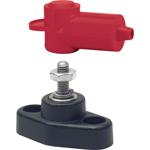More progress was made thru the week on the cabling, I was able to snatch a hour or so of an afternoon before it got too dark outside. Bring on daylight savings!
The fuse holder arrived, and I also took delivery of a link bus bar for joining the RBS and ACR. I procured more 50mm2 cable (using Cigweld superflex for this) and some suitable cable lugs and thick glue lined heat shrink in black and red. I also bought some Projecta battery terminals with the 5/16" threaded bolts to which I'll attach my cables once complete.
The first cable was the negative link which will sit between both batteries. As this area is under the seat box, height is not as much of an issue and the assembly was fairly straight forward. The terminals were approx 173mm apart, so with a bit of measurement and holding the tongue the right way, I knocked that cable together. As the welding cable was orange, I gave it a sheath of black, and provided some cable strain relief around the lug with the black glue lined heatshrink. This will aslo serve as a good protection from the elements, and oxidation of the copper down the track which can lead to increased resistance.
With the fuse holder in place, I measured up the main positive feed to the fuse block. This is an odd shaped cable, as it needs to exit the bottom of the fuse block, wrap around the battery, and approach the cranking battery at a nice angle, while maintaining plenty of working room in the battery box for other stuff.
I repurposed the black plastic cable saddle which was used on the negative cable to train the positive cable into (as close to) a 90 degree bend. More glue lined heat shrink helps to set the bend, and keep the cable path fairly tight to the batteries. The above pic does not really offer any view of how it fits together, but the below pic should:
...and fuse holder with cover on:
For anyone interested, the earth lead on the factory setup is a 50mm2 cable, but it's got this horrendous hard plastic sheath which makes it almost impossible to get anything tighter than a 150mm diameter bend in it. I lopped the factory terminal arrangement off with extreme prejudice. I think it's clear already how much I hated that arrangement. It's now replaced with a 50mm2 lug, and 8mm diameter hole to match the battery post.
Depending on motivation levels, I might actually relocate this earth cable thru a cable gland lower to the bottom of the battery box, and re-make it with a better cable. Only issue is my ability to crimp a lug in the middle of the cable, as it needs to earth to chassis then the gearbox. This will of course necessitate the sealing of all the holes I now have in the battery box. The path of dynamat in there is getting ever more tempting! It will also help to deaden the large clunk noise that the RBS and ACR will make as they actuate- the rear of the battery box is essentially a drum skin.
The ACR and RBS are bolted in temporarily, there is a hole behind the RBS which I need to plug (this is where the negative cable originally came thru). I've used stainless hardware here, 5mm hex head cap bolts and nylock nuts. I'd prefer if they never came loose and shorted out on anything. That would be rather embarrassing.
Still deciding which position the ACR and RBS should be. The ACR needs a cable to go to each battery, which may be an interesting one to route. Likewise, the RBS needs to feed to a fuse block and then to the winch (and go over the top of the gearbox). Each way has it's own advantages, and I'll probably go for the way that looks nicest, and has best utilization of the space at hand.




 Reply With Quote
Reply With Quote








Bookmarks